Count me in: Kolea count 2024-2025
 Count me in. please. ©Tom Fake
Count me in. please. ©Tom Fake
November 22, 2024
December 1st starts this winter’s annual kolea count. On this site’s contact tab, please tell me where you want to count and I’ll sign you up. I created these counting sites from maps but you can count anywhere you live, work, or walk. I enjoy driving to new places to count kōlea. It gives me mini-outings on my own island.
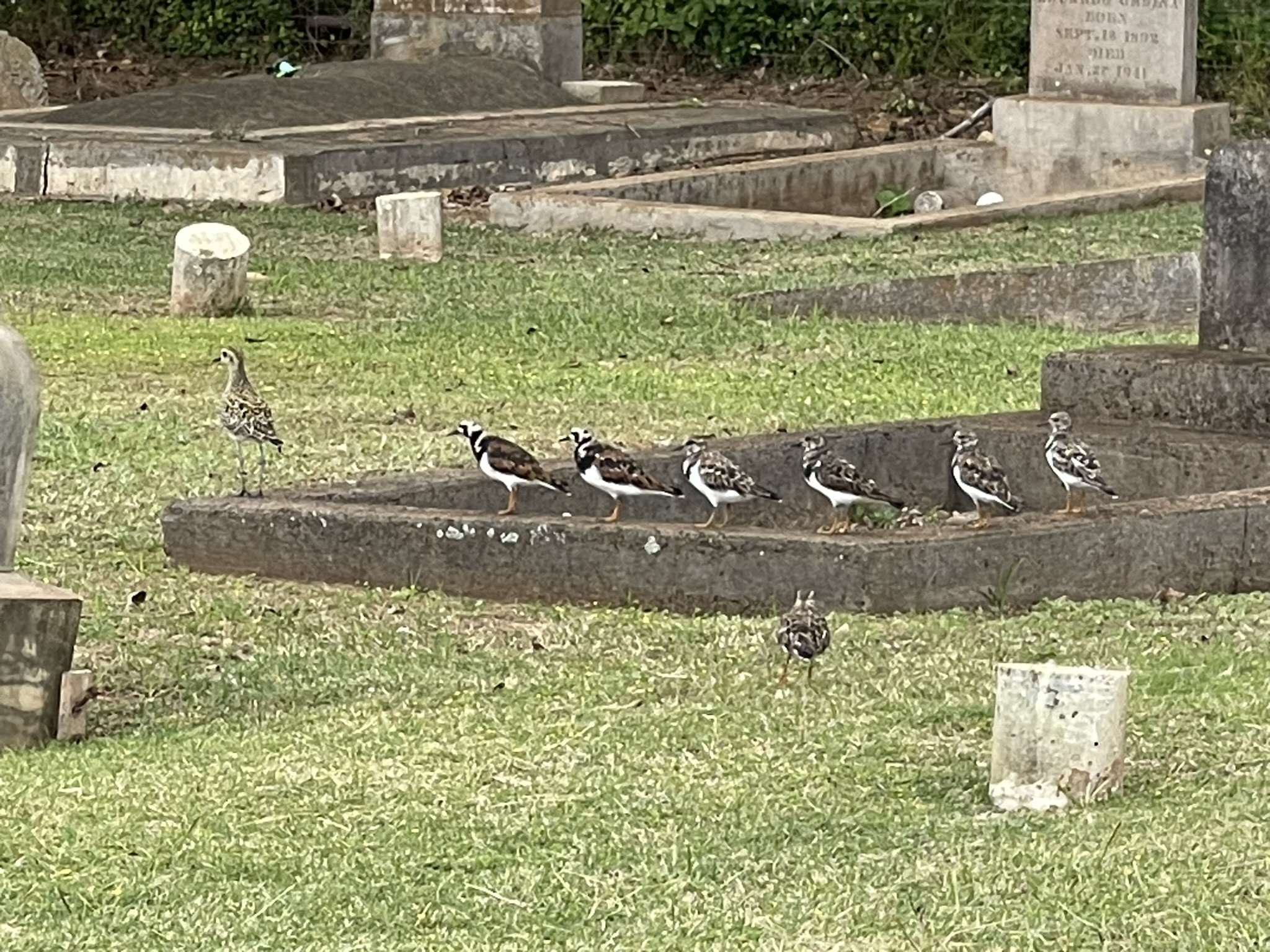 This kōlea seems to be leading a parade of ʻakekeke, or ruddy turnstones. The species often forage together. Puʻuiki Cemetery in Waialua is one of the places I count. ©Susan Scott
This kōlea seems to be leading a parade of ʻakekeke, or ruddy turnstones. The species often forage together. Puʻuiki Cemetery in Waialua is one of the places I count. ©Susan Scott
Although our plovers have been arriving in Hawaiʻi since August, we start the count in December to give the summer’s offspring time to get settled and get counted.
Chicks hatched on the Alaska tundra in late June/early July forage for insects and berries there as long as weather permits, sometimes as late as November. When the snows fall, the kids head south. Alone. How kōlea and other migratory shorebirds find Hawaiʻi, or any other Pacific Islands, is one of nature’s miracles.
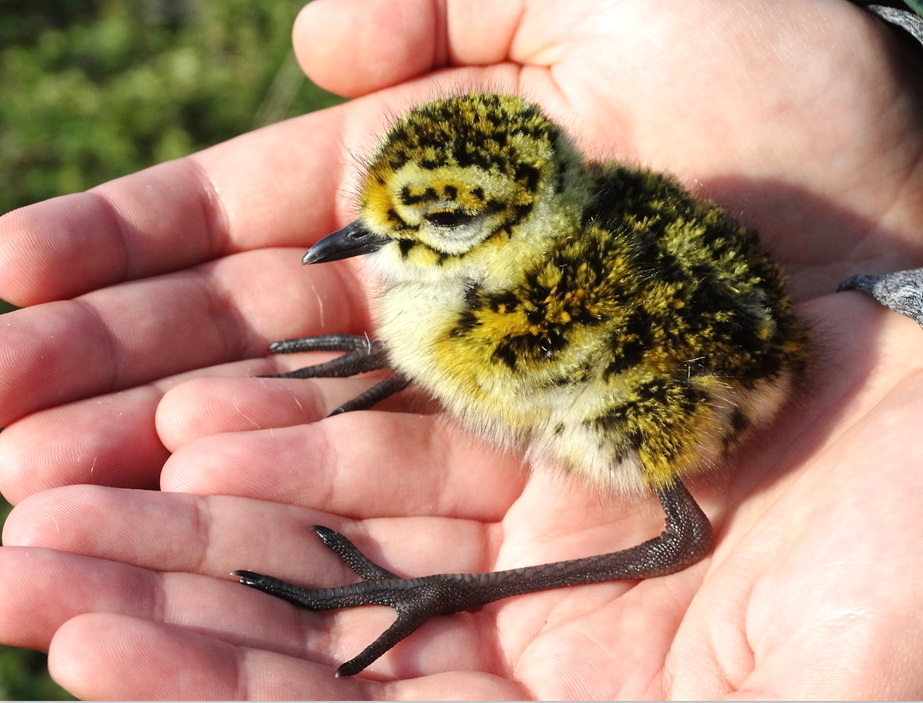 A newly hatched kōlea chick in Alaska. Legs are adult-sized at hatching. ©Wally Johnson
A newly hatched kōlea chick in Alaska. Legs are adult-sized at hatching. ©Wally Johnson
 Shorebird parents don’t feed their chicks but follow the youngsters as they forage. Parents sit on their chicks to warm them when weather turns stormy. ©Wally Johnson
Shorebird parents don’t feed their chicks but follow the youngsters as they forage. Parents sit on their chicks to warm them when weather turns stormy. ©Wally Johnson
Not all offspring survive the journey, and some that do run into trouble when they land in a territory established by an adult. Young birds that find their own space, and make it through the winter are hardy survivors. E komo mai, kids.
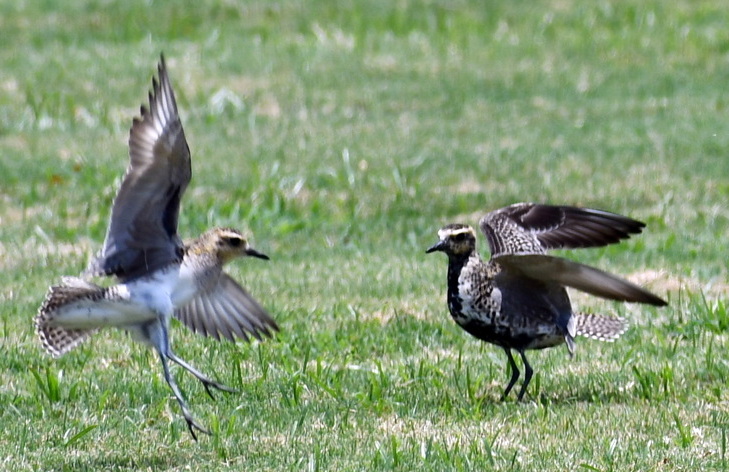 When this young plover (left) trespassed on another’s patch, the established owner put up a fight. The squabble occurred in Punchbowl Cemetery. The newcomer moved on. (First year birds have no breeding colors.) ©Susan Scott
When this young plover (left) trespassed on another’s patch, the established owner put up a fight. The squabble occurred in Punchbowl Cemetery. The newcomer moved on. (First year birds have no breeding colors.) ©Susan Scott
You can’t do this wrong. Besides helping gather data about the birds, counting kōlea gives us special moments to appreciate the marvel we call kōlea.

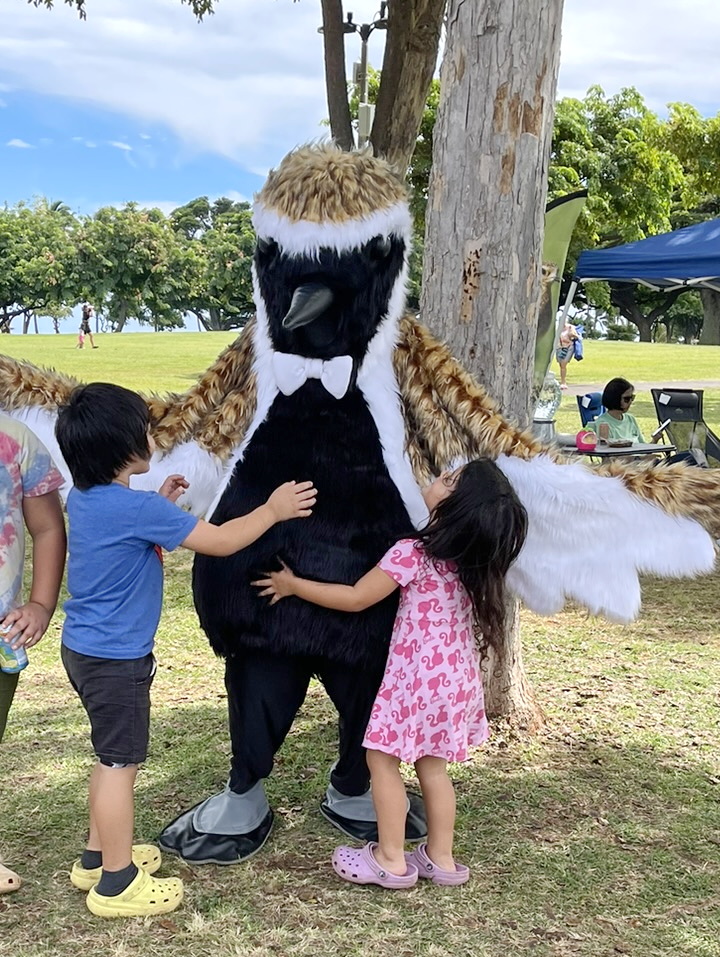
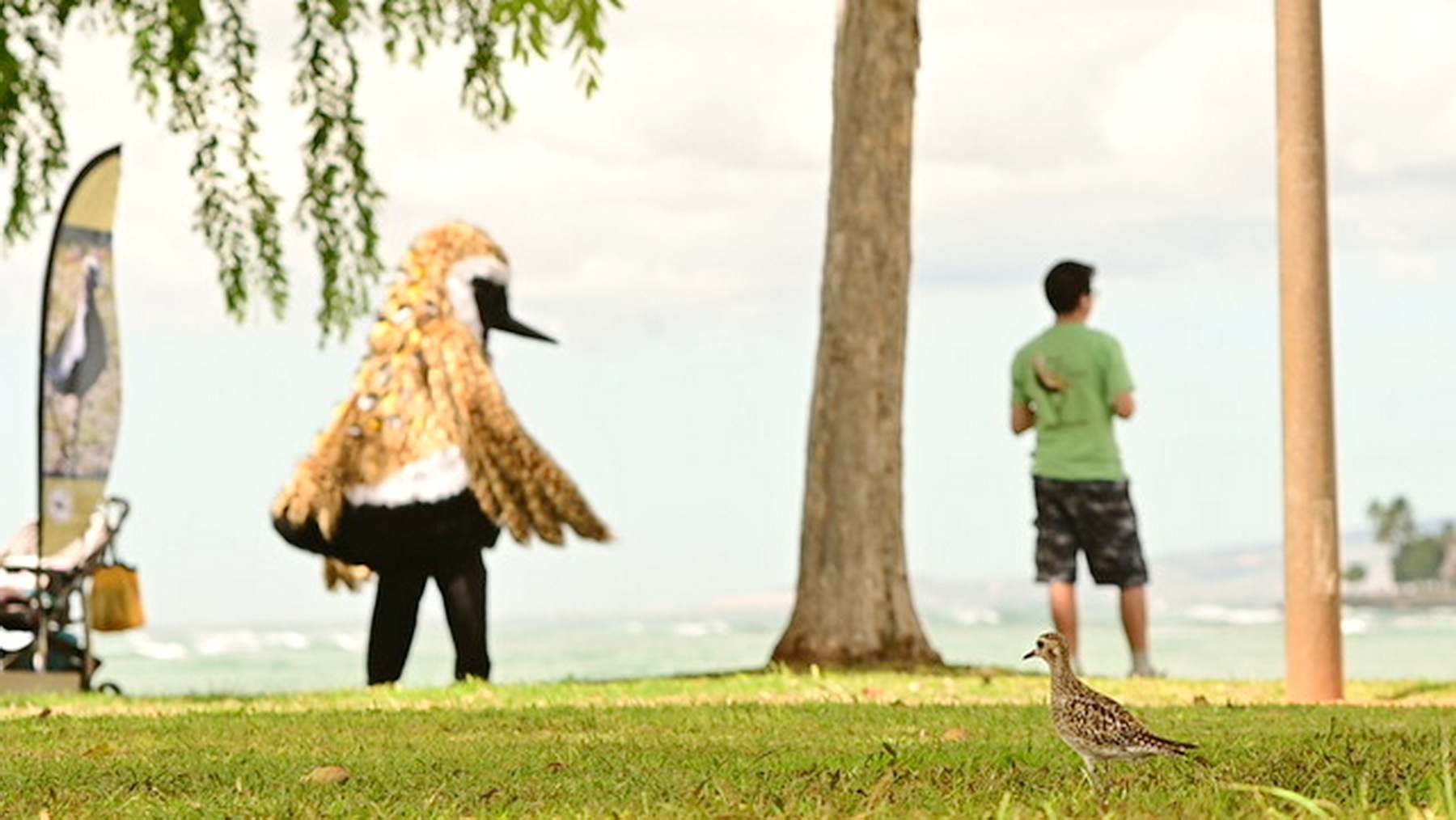 Four kōlea: From left, the new kōlea-in-tuxedo flag, mascot Kōlea Nui, volunteer Andres Jojoa Ortega in his EVERY KŌLEA COUNTS T-shirt, and lower right, a curious resident kōlea checking out its namesakes. © Christiaan Phleger
Four kōlea: From left, the new kōlea-in-tuxedo flag, mascot Kōlea Nui, volunteer Andres Jojoa Ortega in his EVERY KŌLEA COUNTS T-shirt, and lower right, a curious resident kōlea checking out its namesakes. © Christiaan Phleger 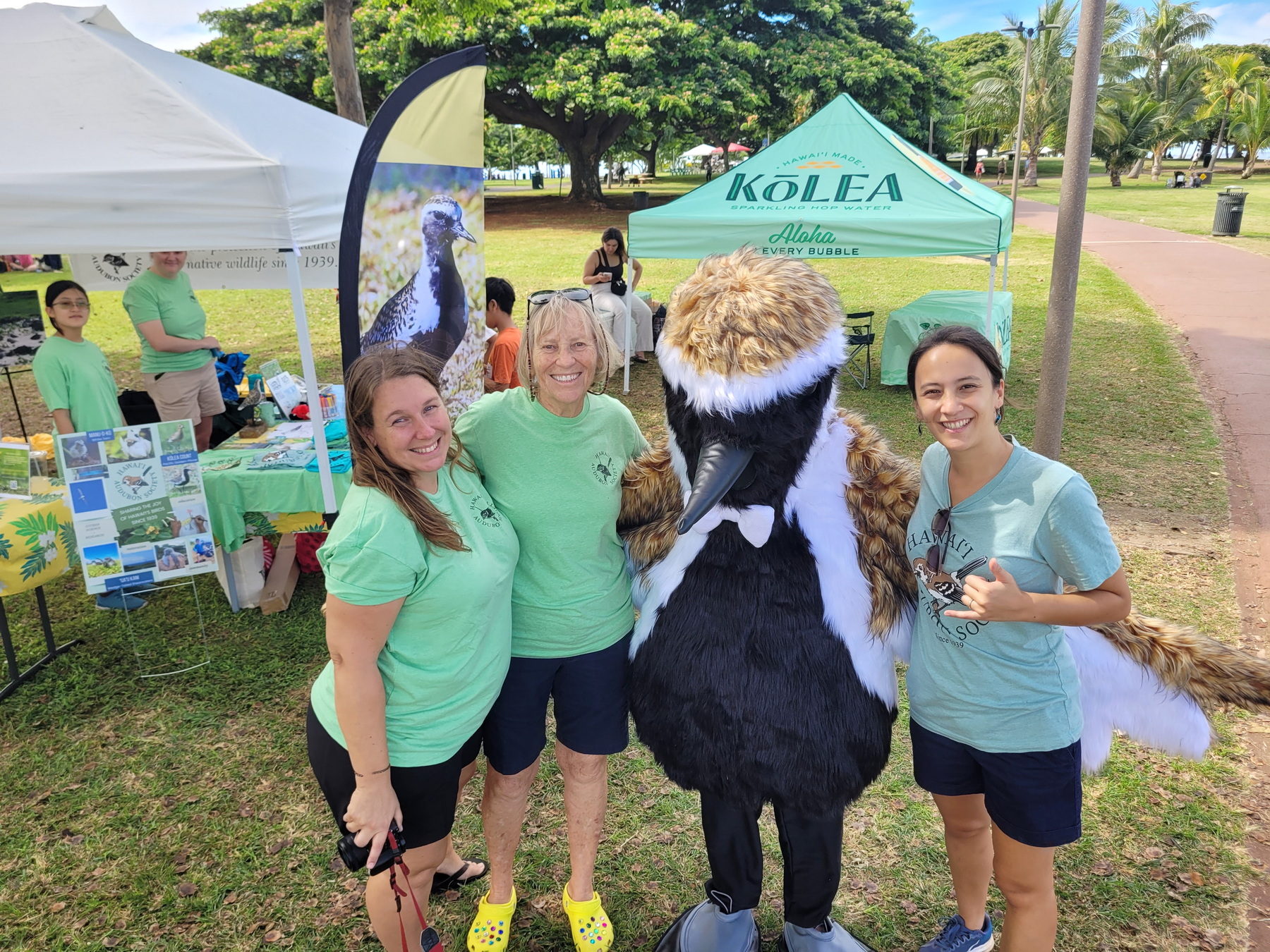 Hawaiʻi Audubon’s Team Kōlea: Foreground from left, Operations Manager Laura Doucette, me, mascot Kōlea Nui, and Education Manager, Elena Arinaga. Left background are Taylor Kim and Charlotte Bender, two of four Kapiolani Community College students who helped with the festival.
Hawaiʻi Audubon’s Team Kōlea: Foreground from left, Operations Manager Laura Doucette, me, mascot Kōlea Nui, and Education Manager, Elena Arinaga. Left background are Taylor Kim and Charlotte Bender, two of four Kapiolani Community College students who helped with the festival. 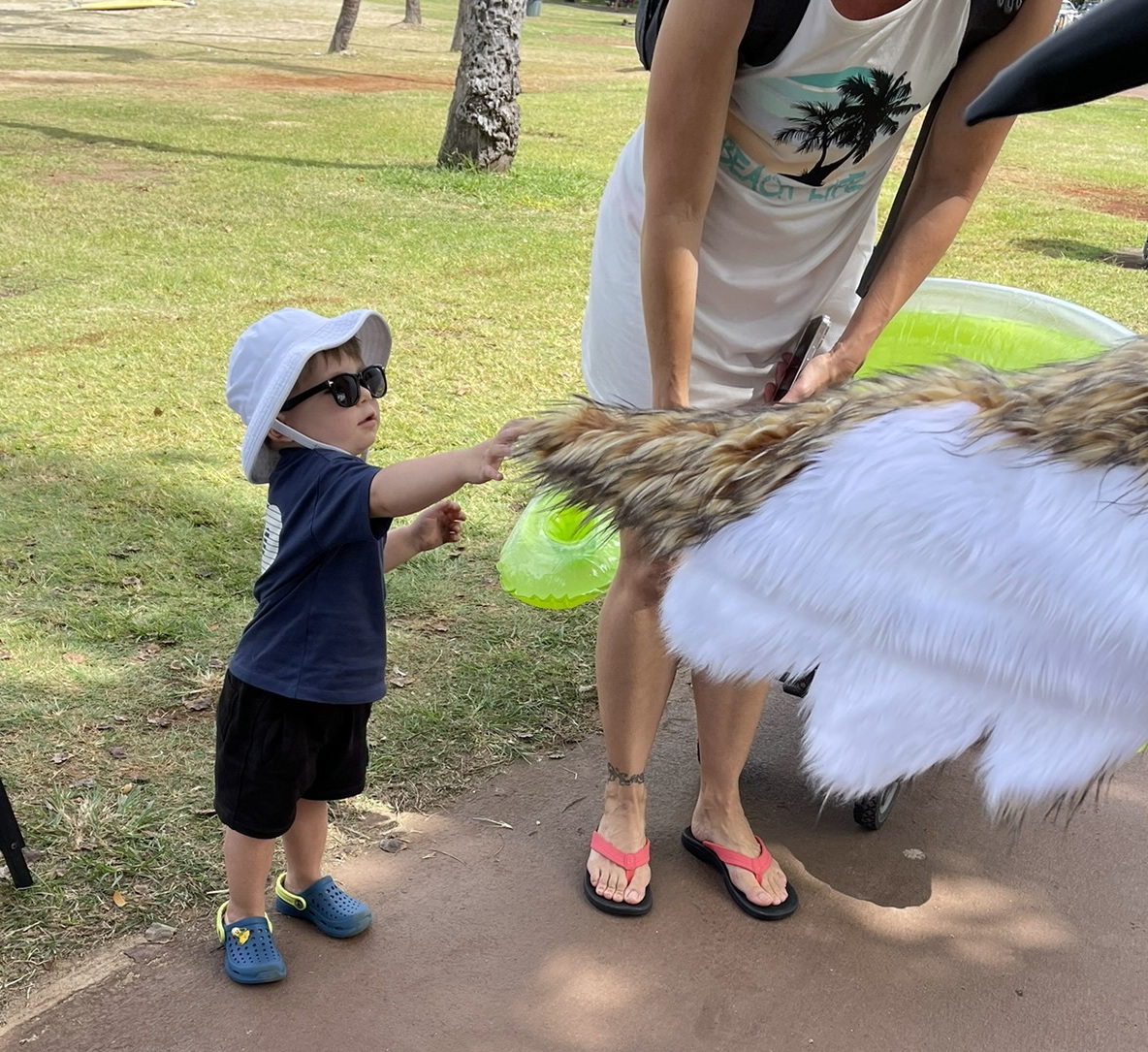
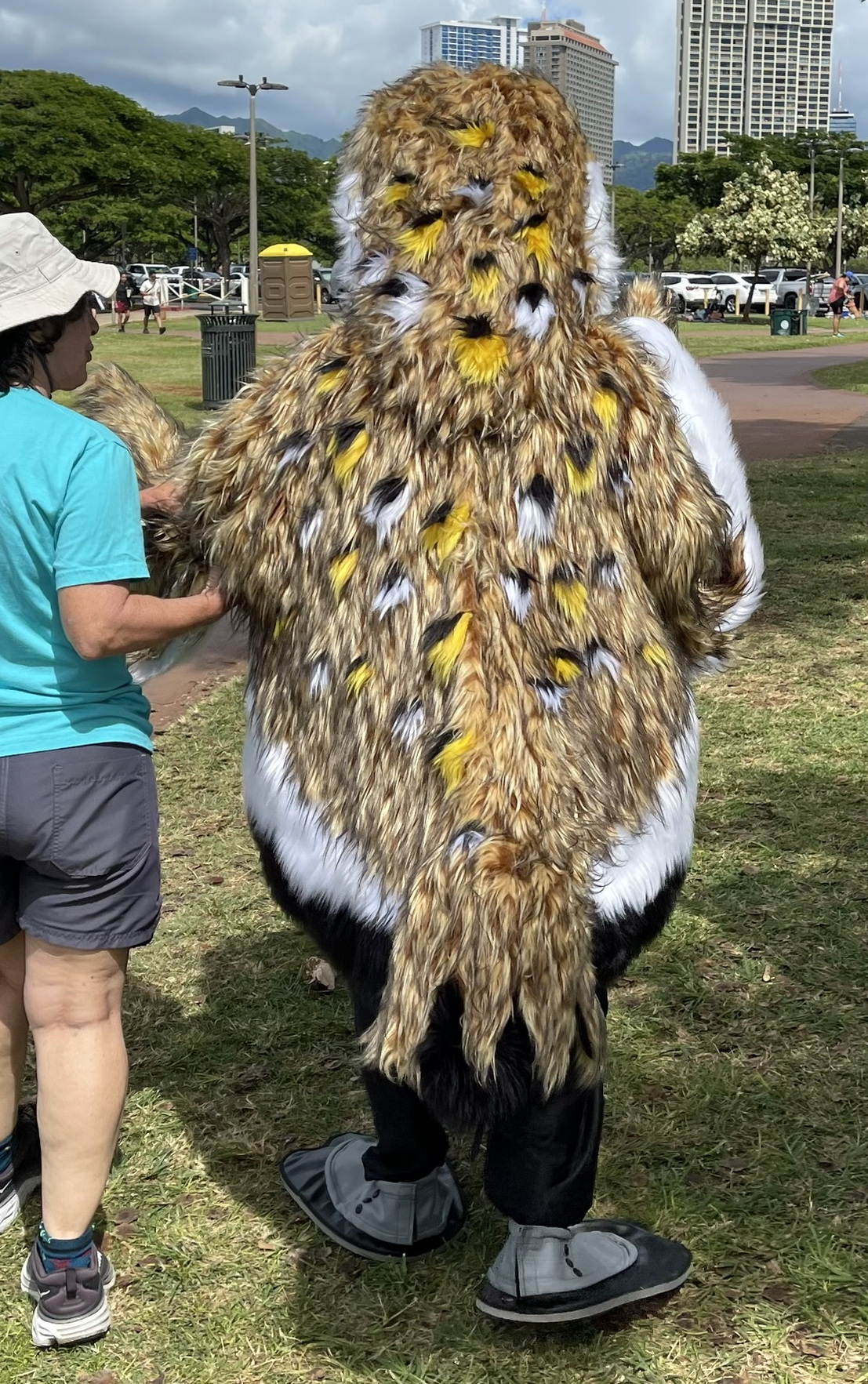
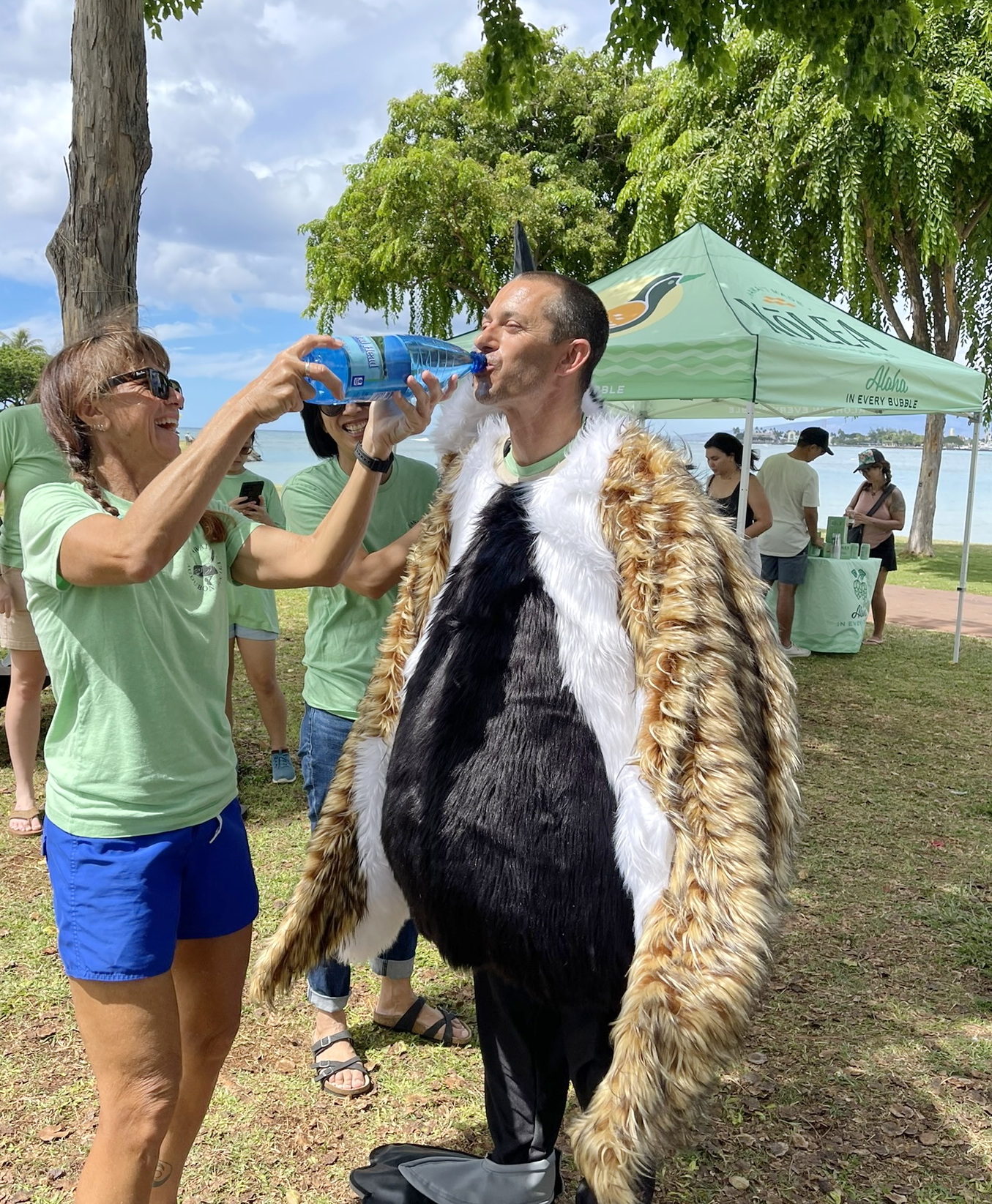 MJ Mazurek gives Kōlea Nui (AKA Josh Fisher) a cold drink of water. Even with an ice-pack vest and a head fan, hugging and dancing with children is hot work. Volunteers took turns wearing the costume. ©Susan Scott
MJ Mazurek gives Kōlea Nui (AKA Josh Fisher) a cold drink of water. Even with an ice-pack vest and a head fan, hugging and dancing with children is hot work. Volunteers took turns wearing the costume. ©Susan Scott 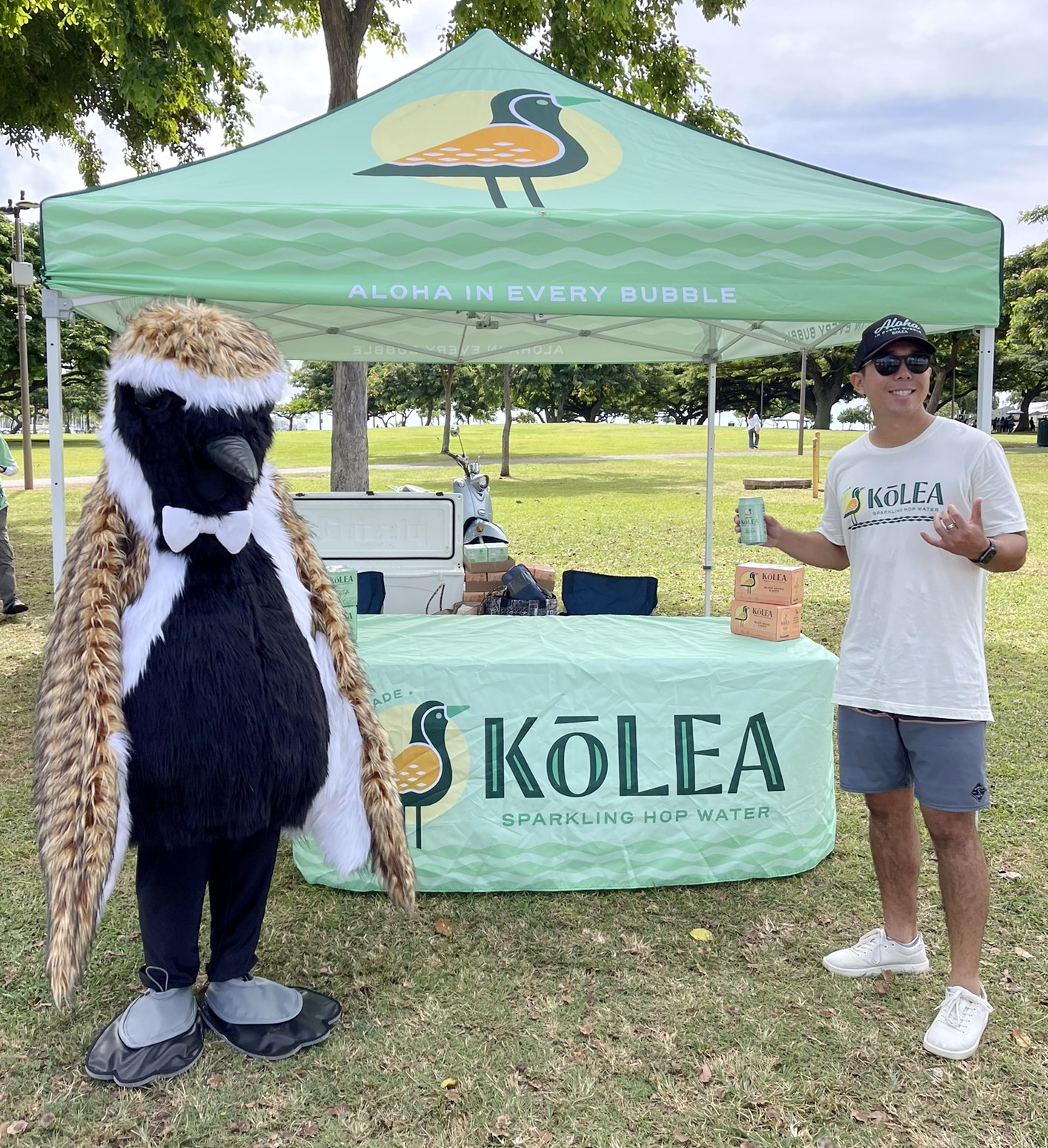 Representatives of the new drink, Kōlea Sparkling Hop Water, (zero alcohol, zero calories) shared the Kōlea Festival with us. Everyone enjoyed the free samples, as well as the company’s logo. ©Susan Scott
Representatives of the new drink, Kōlea Sparkling Hop Water, (zero alcohol, zero calories) shared the Kōlea Festival with us. Everyone enjoyed the free samples, as well as the company’s logo. ©Susan Scott 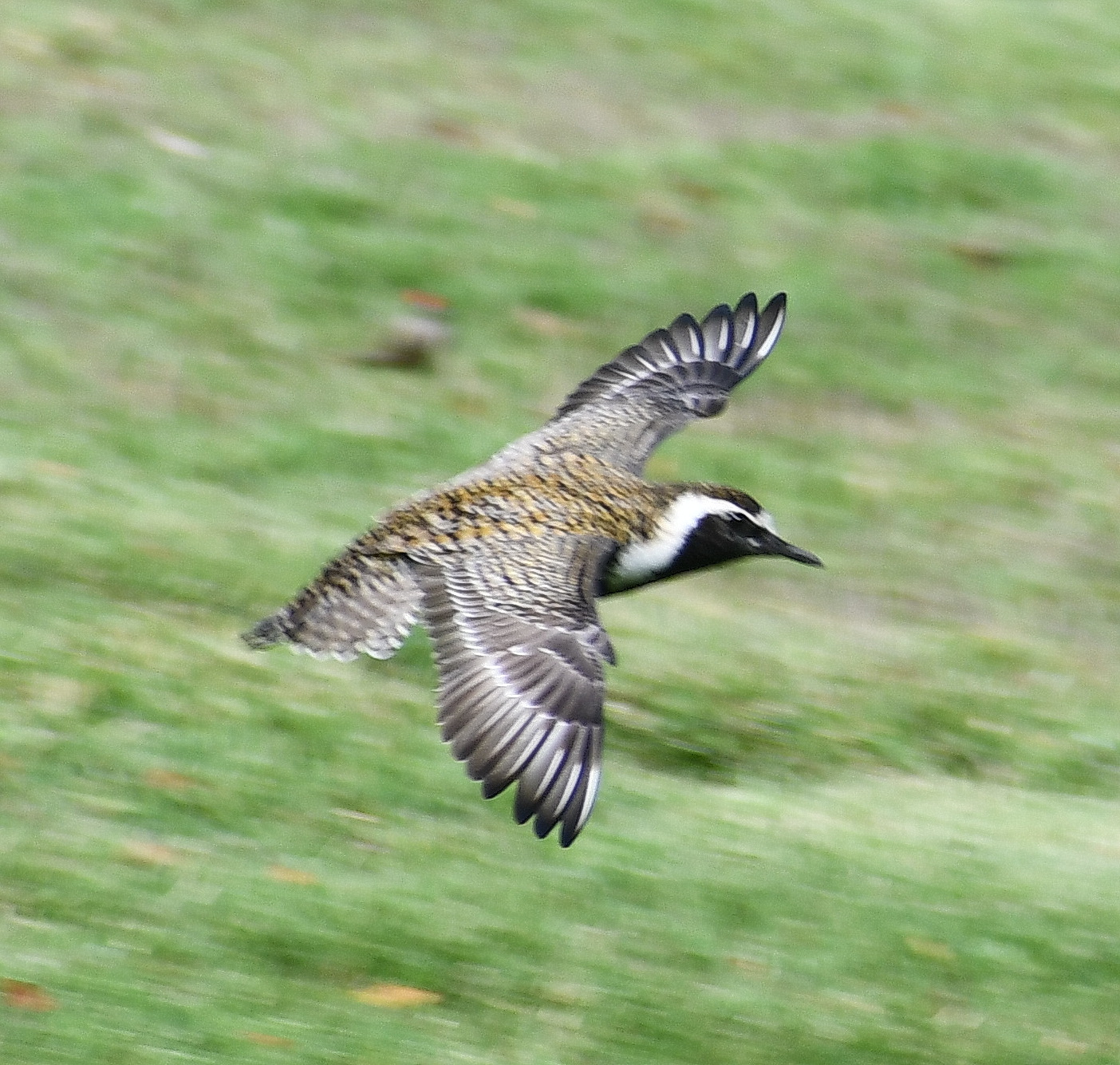


 Puuiki Cemetery, Waialua September 2, 2024. ©Susan Scott
Puuiki Cemetery, Waialua September 2, 2024. ©Susan Scott 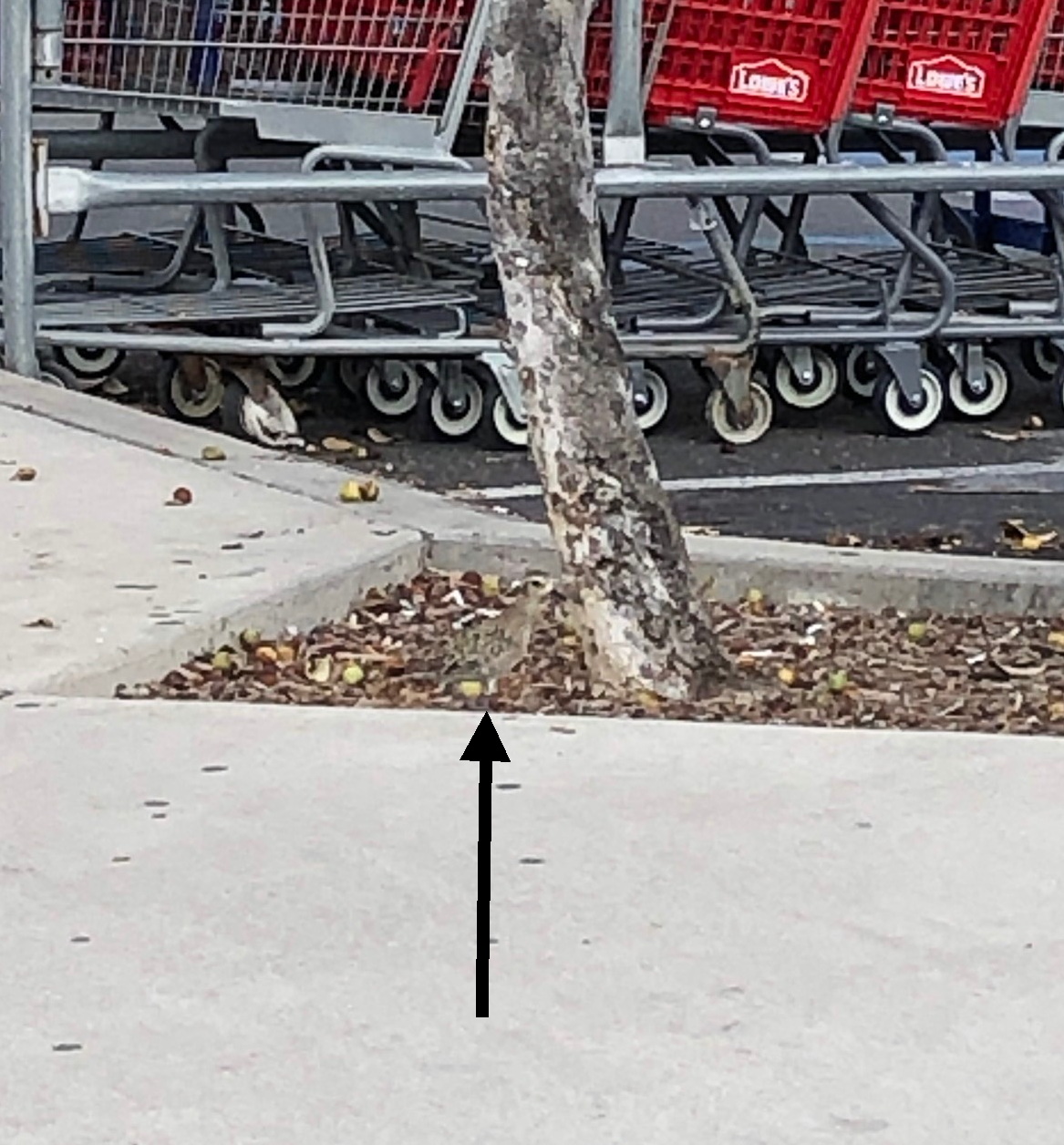 A Lowe’s parking lot kōlea. Elton Miyagawa photo.
A Lowe’s parking lot kōlea. Elton Miyagawa photo. 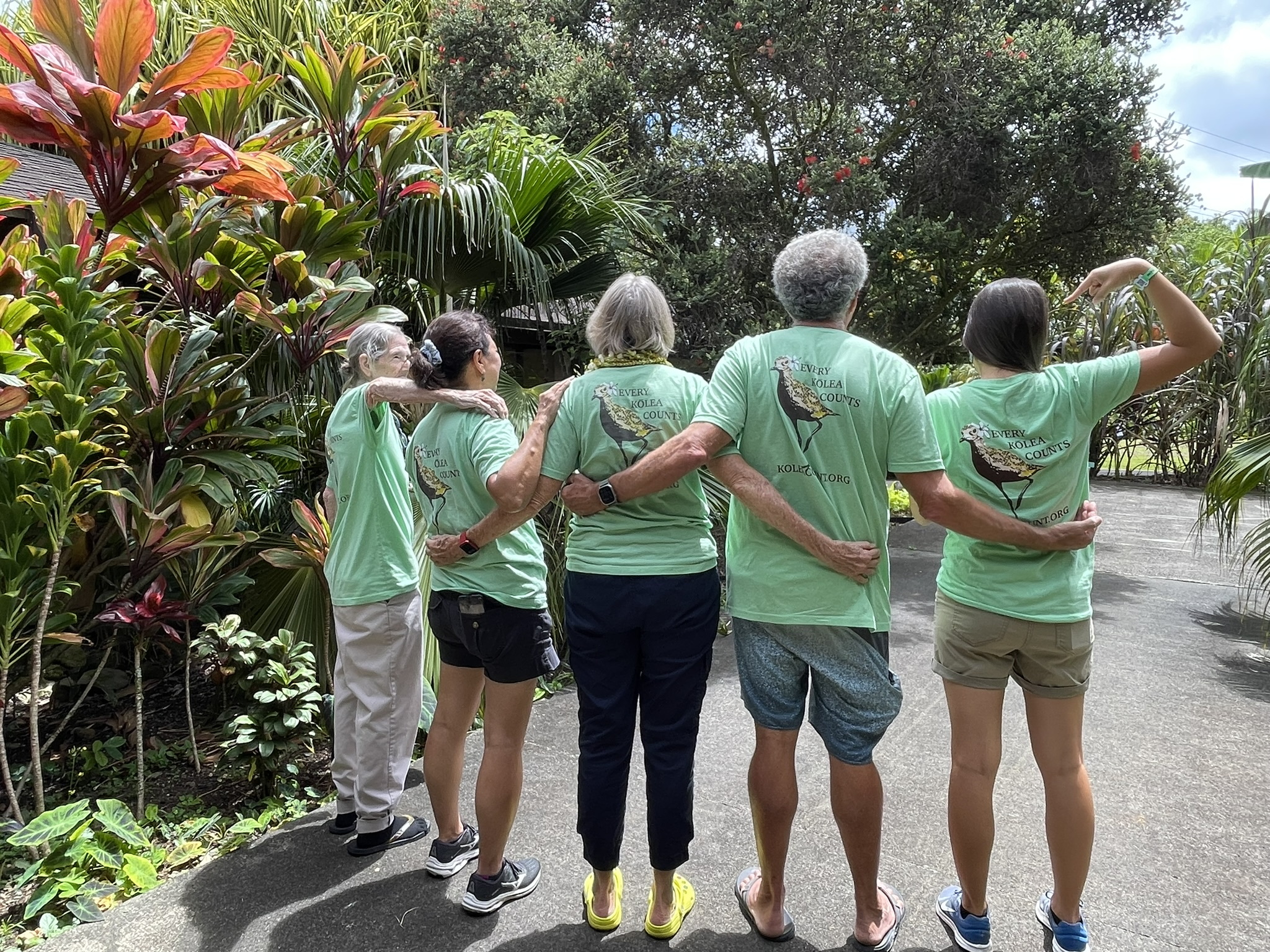 Hawaii Audubon Society members show off their kōlea fandom at Hoʻomaluhia Botanical Garden on September 6. Memberships and Ts, available at Hawaii Audubon.org, help support research and education.
Hawaii Audubon Society members show off their kōlea fandom at Hoʻomaluhia Botanical Garden on September 6. Memberships and Ts, available at Hawaii Audubon.org, help support research and education. 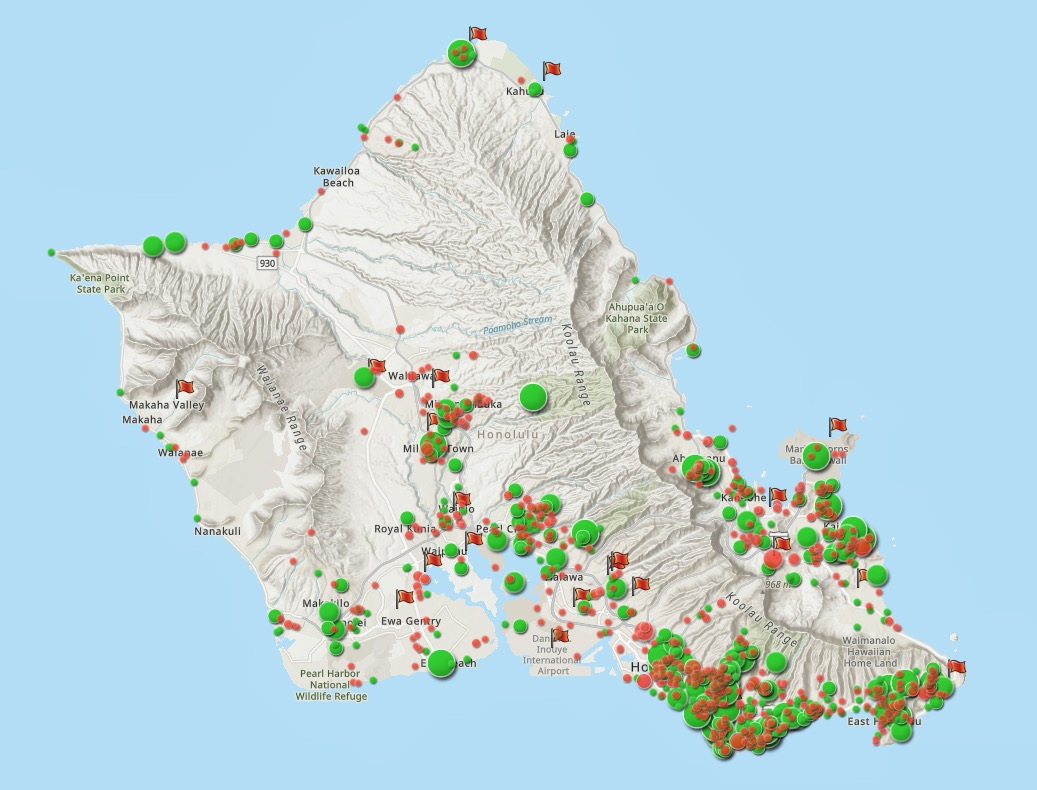 Flags show golf courses, ideal habitat for our kōlea but currently far under-counted. Green dots are kōlea locations reported in 2023-2024 season. Orange dots are plovers reported in previous years but not 2023-2024. Dot sizes reflect number of years reported. Rich Downs image.
Flags show golf courses, ideal habitat for our kōlea but currently far under-counted. Green dots are kōlea locations reported in 2023-2024 season. Orange dots are plovers reported in previous years but not 2023-2024. Dot sizes reflect number of years reported. Rich Downs image.  Kōlea Count and eBird data layered over a Hawaii Land Cover map. Rich Downs image.
Kōlea Count and eBird data layered over a Hawaii Land Cover map. Rich Downs image. 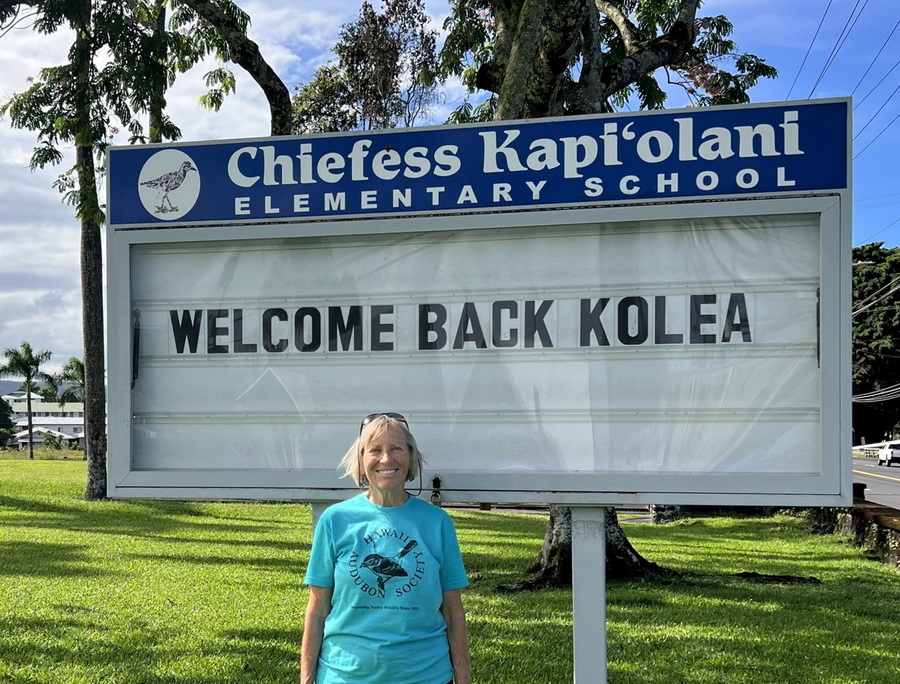
 This sign demanded a photo stop during a Hilo visit last year. The kōlea (upper left image on sign) is apparently the Chiefess Kapiʻolani Elementary School’s mascot. ©Wendy Kuntz
This sign demanded a photo stop during a Hilo visit last year. The kōlea (upper left image on sign) is apparently the Chiefess Kapiʻolani Elementary School’s mascot. ©Wendy Kuntz 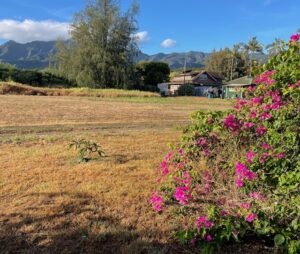
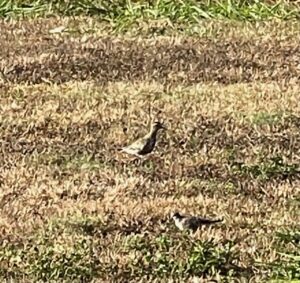 Bougie has returned to this space off Crozier Drive in Waialua for at least five years. (Zebra dove in foreground.) Our phone cameras may not take the best distance photos, but they’re in our pockets to capture the moment.
Bougie has returned to this space off Crozier Drive in Waialua for at least five years. (Zebra dove in foreground.) Our phone cameras may not take the best distance photos, but they’re in our pockets to capture the moment. 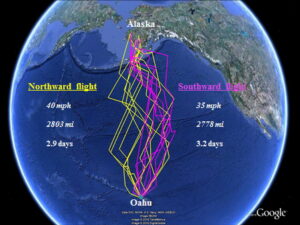 From Wally Johnson’s tracking studies. © O.W. Johnson
From Wally Johnson’s tracking studies. © O.W. Johnson 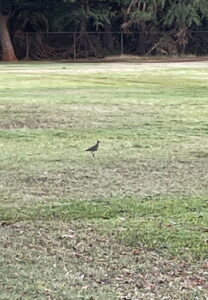 July 25, 2024, Oahu, undisclosed location) © Ann Egleston
July 25, 2024, Oahu, undisclosed location) © Ann Egleston 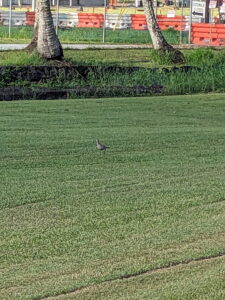 August 9, 2024, Kamehameha soccer field, Hilo ©Jo-Ann Garrigan
August 9, 2024, Kamehameha soccer field, Hilo ©Jo-Ann Garrigan 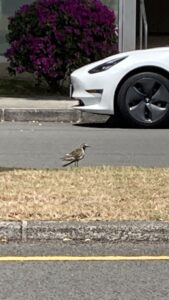 July 25, Niu Valley, © Patricia Johnson
July 25, Niu Valley, © Patricia Johnson 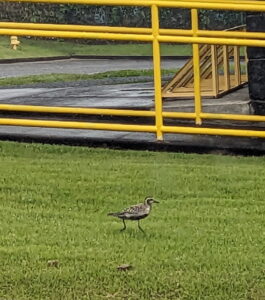 August 2, Hilo Public Library, © Jo-Ann Garrigan
August 2, Hilo Public Library, © Jo-Ann Garrigan 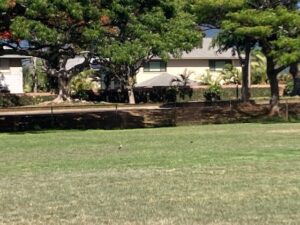 August 6, Kuahelani Park, Mililani © Tempe Kapela
August 6, Kuahelani Park, Mililani © Tempe Kapela 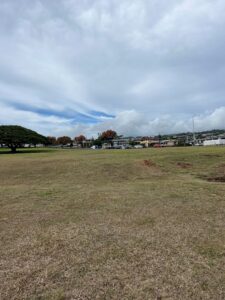 July 30, Waiau district Park, © Evelyn Nakanishi
July 30, Waiau district Park, © Evelyn Nakanishi 
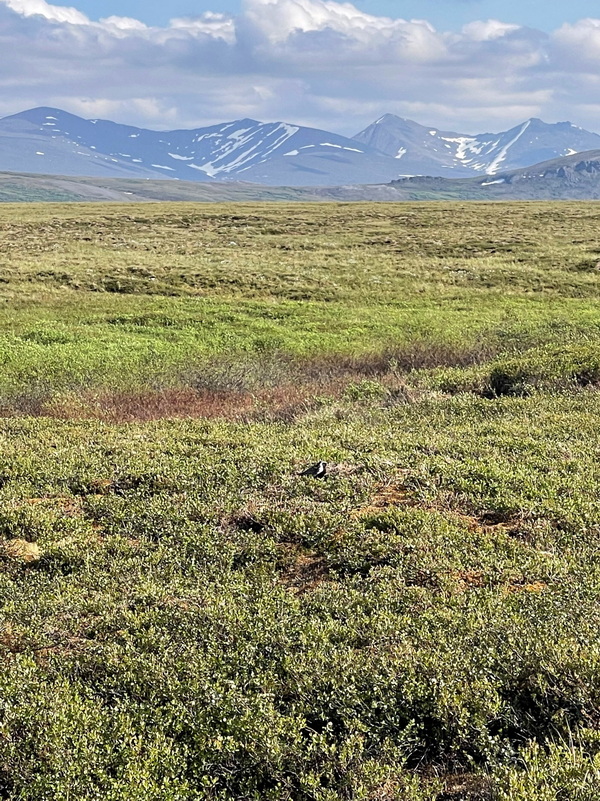
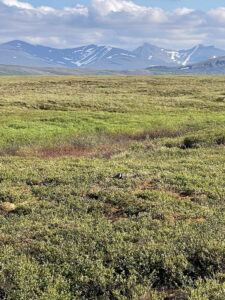 A kōlea on the Nome tundra. ©Susan Scott
A kōlea on the Nome tundra. ©Susan Scott 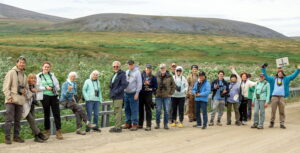 ©Laura Doucette
©Laura Doucette 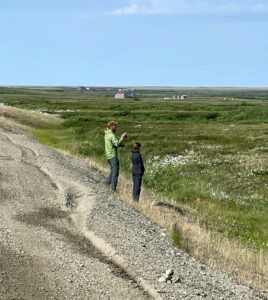 Wally’s long-time field workers, Paul and Nancy Brusseau, scouting for kōlea. ©Susan Scott
Wally’s long-time field workers, Paul and Nancy Brusseau, scouting for kōlea. ©Susan Scott 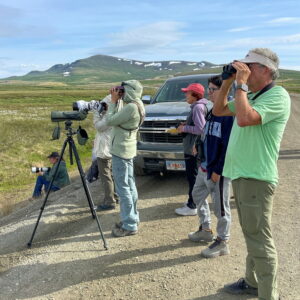 Members of our group looking for birds. ©Susan Scott
Members of our group looking for birds. ©Susan Scott 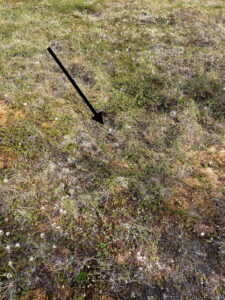 ©Susan Scott
©Susan Scott 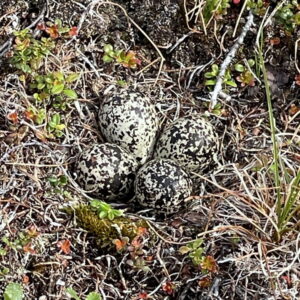 ©Susan Scott
©Susan Scott 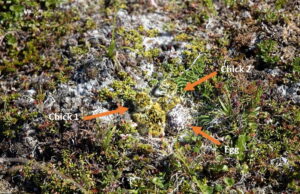 ©Laura Doucette
©Laura Doucette 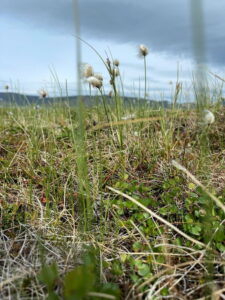 Wally posed this question: If we tall humans have a hard time finding a nest, how do little birds do it? This photo, taken by me on my belly, as Wally suggested, is a kōlea-eye view of the tundra. ©Susan Scott
Wally posed this question: If we tall humans have a hard time finding a nest, how do little birds do it? This photo, taken by me on my belly, as Wally suggested, is a kōlea-eye view of the tundra. ©Susan Scott 
 Besides learning new things, kōlea help us to make new friends. Plover fan Roger Kobayashi (right) hosts me several times a year at Ford Island (a contractor working there took this photo of us) and Tripler Army Medical Center to watch kōlea gather. On Saturday, only 6 birds remained, a gradual decrease from a high of 110.
Besides learning new things, kōlea help us to make new friends. Plover fan Roger Kobayashi (right) hosts me several times a year at Ford Island (a contractor working there took this photo of us) and Tripler Army Medical Center to watch kōlea gather. On Saturday, only 6 birds remained, a gradual decrease from a high of 110.  This kōlea learned to eat mealworms from the home owner’s hand. The bird returned to the man’s Kailua yard for 15 years.
This kōlea learned to eat mealworms from the home owner’s hand. The bird returned to the man’s Kailua yard for 15 years. 
 If you feed your bird, please offer high protein food, such as worms or scrambled egg. This is my Jake, at least eight years old, eating his egg. His last day on my lanai was April 20th.
If you feed your bird, please offer high protein food, such as worms or scrambled egg. This is my Jake, at least eight years old, eating his egg. His last day on my lanai was April 20th. 

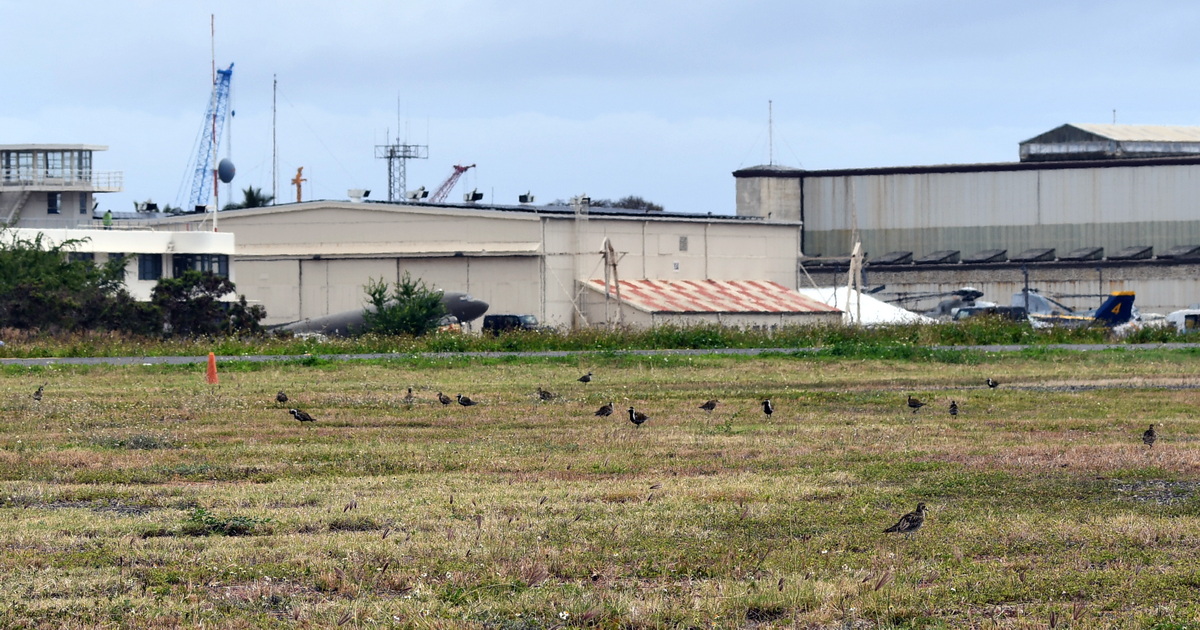
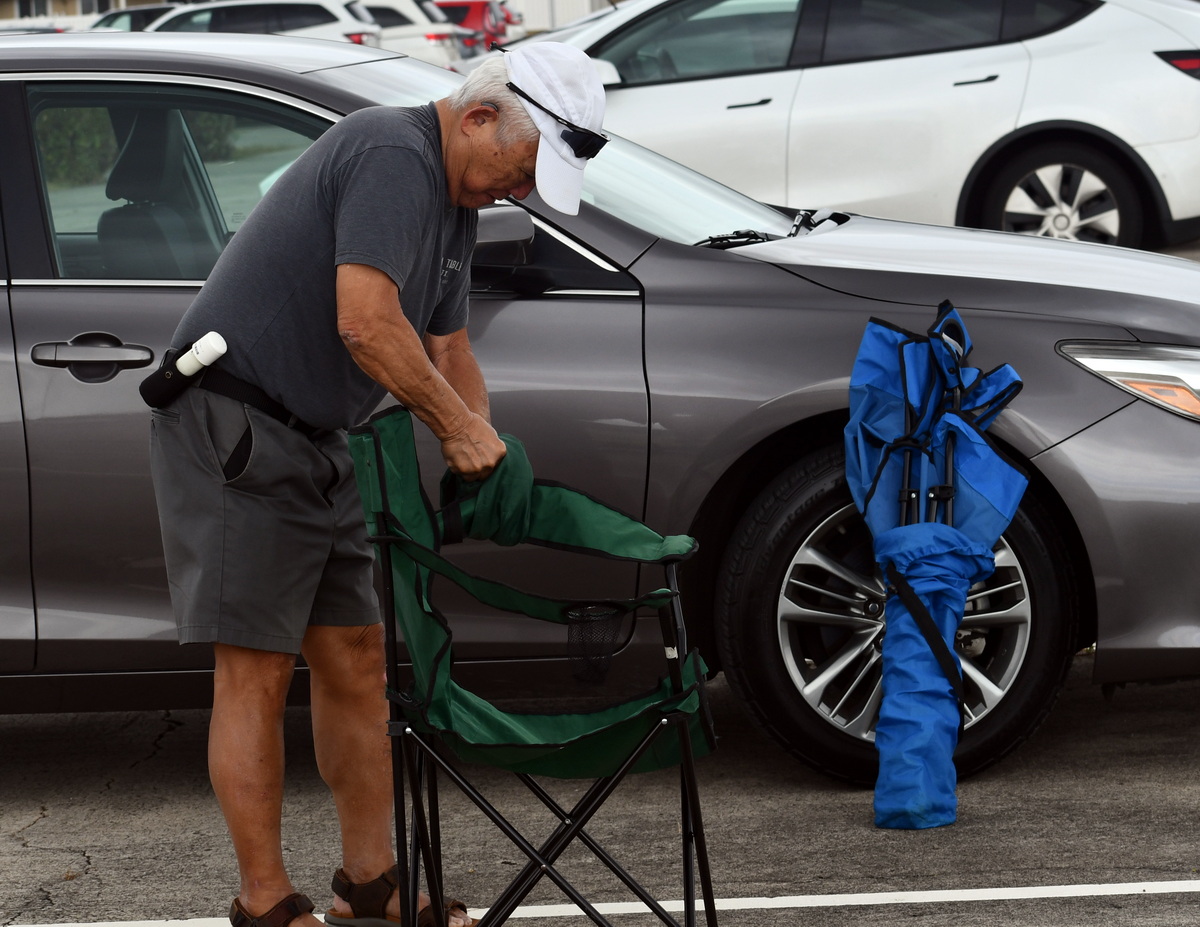 Roger Kobayashi unfolds chairs for our kōlea watch. ©Susan Scott
Roger Kobayashi unfolds chairs for our kōlea watch. ©Susan Scott 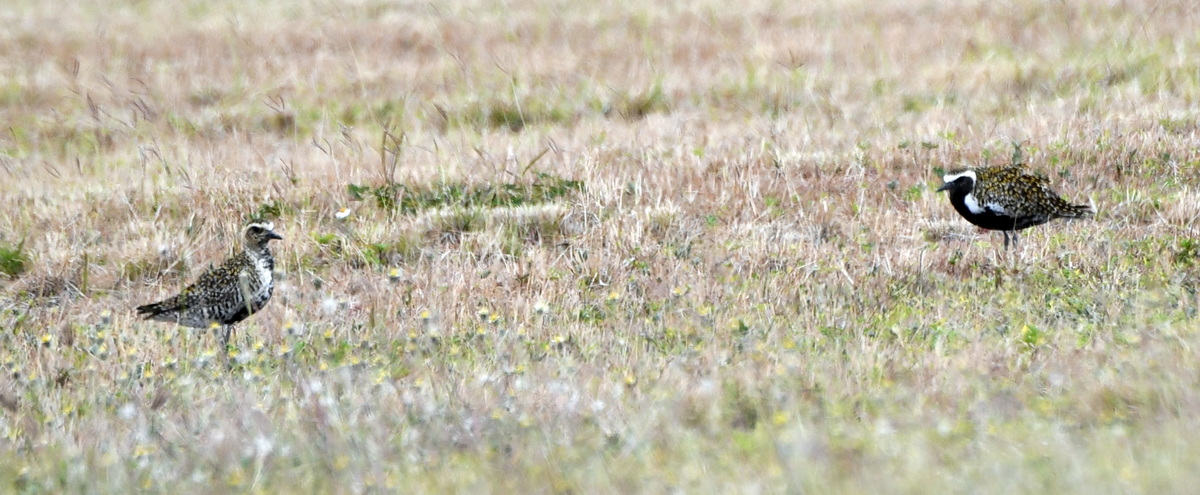
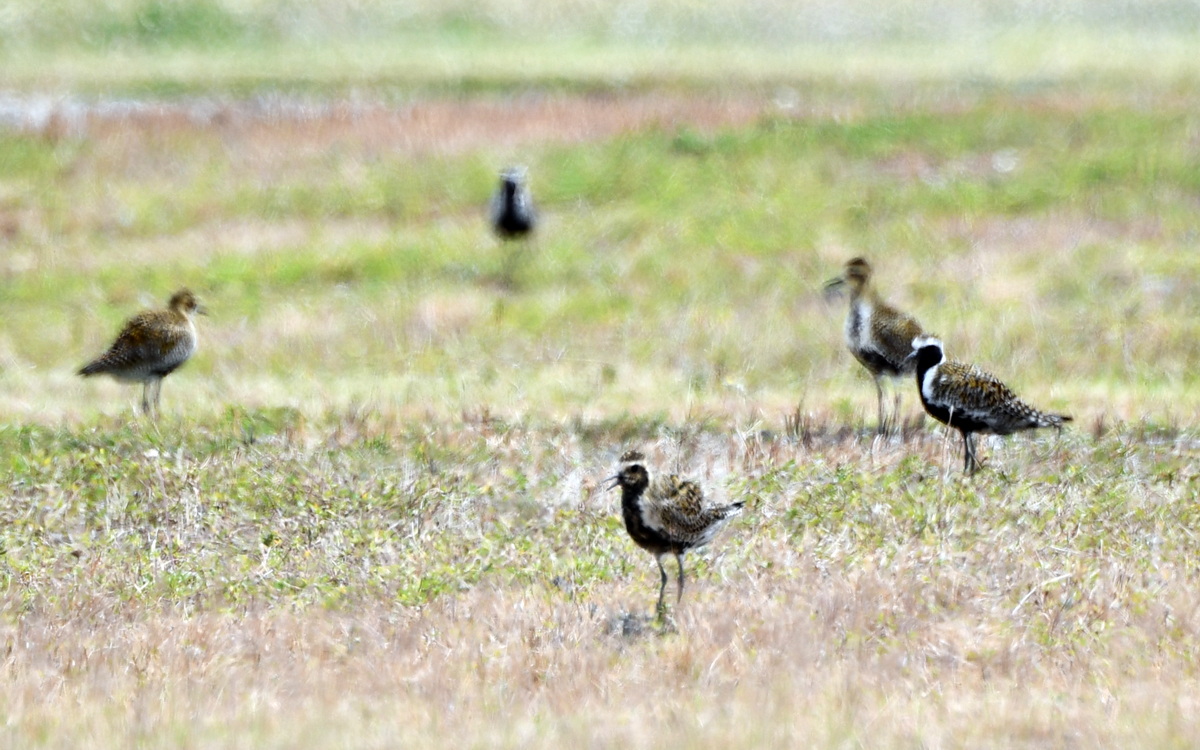 From our distance, the male/female mix seemed about equal. ©Susan Scott
From our distance, the male/female mix seemed about equal. ©Susan Scott 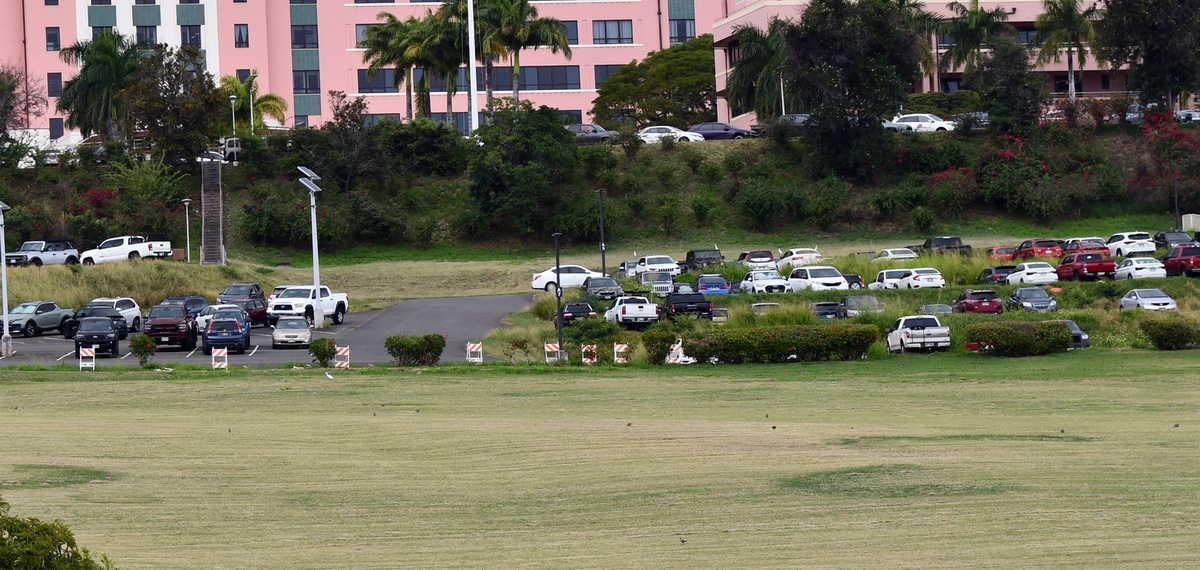 The black dots in this Tripler Army Medical Center (pink building) field are kōlea. ©Susan Scott
The black dots in this Tripler Army Medical Center (pink building) field are kōlea. ©Susan Scott  After Roger contacted me with the gathering news, I drove to Kualoa Park to see if kōlea are gathering there. They were not. I’ll keep checking. ©Susan Scott
After Roger contacted me with the gathering news, I drove to Kualoa Park to see if kōlea are gathering there. They were not. I’ll keep checking. ©Susan Scott 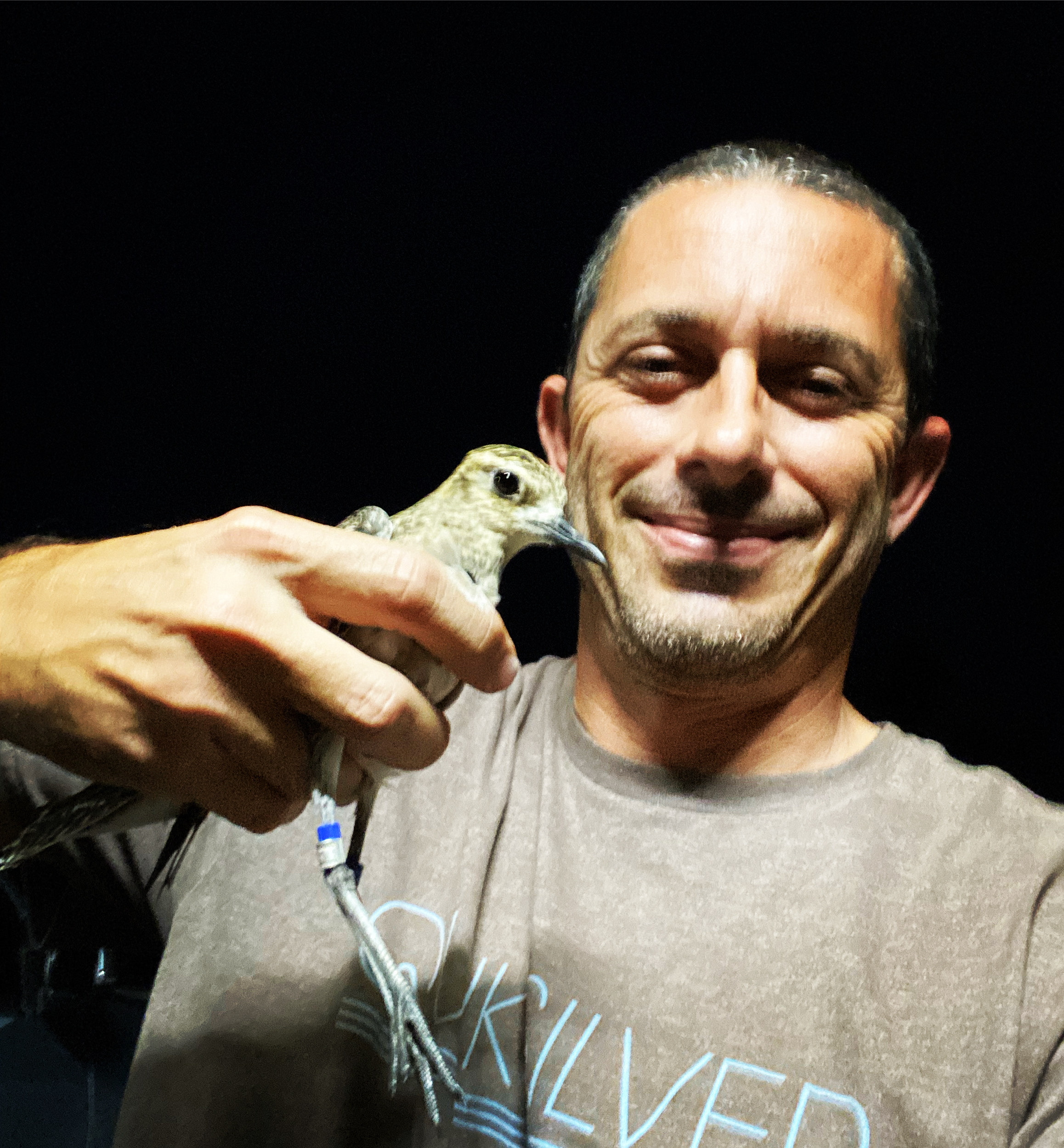
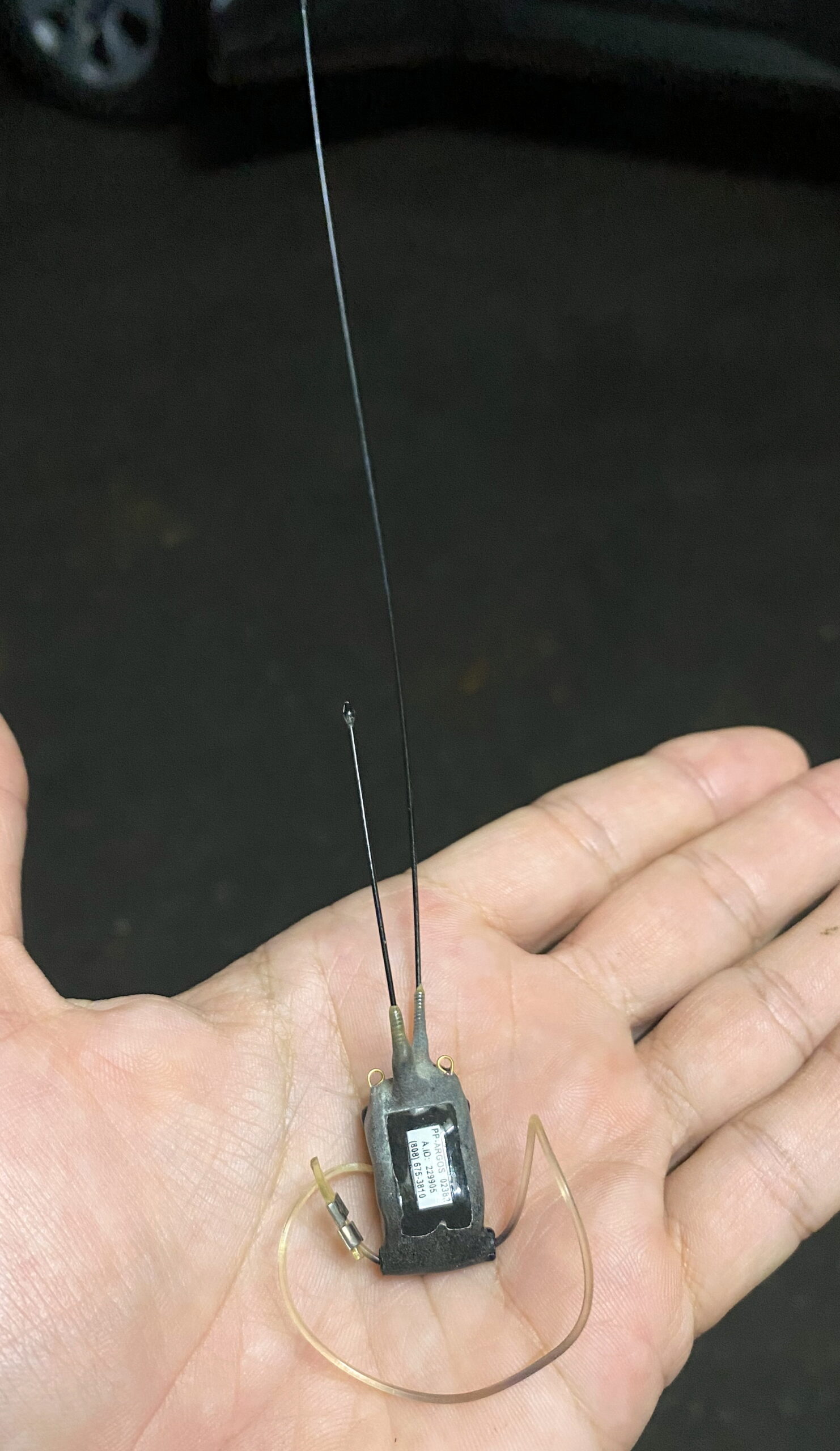 Unfortunately, the batteries in these satellite-signaling devices only have enough charge for one season. Total weight of the device and harness is a bit less than one U.S. nickle. Wally Johnson photo
Unfortunately, the batteries in these satellite-signaling devices only have enough charge for one season. Total weight of the device and harness is a bit less than one U.S. nickle. Wally Johnson photo 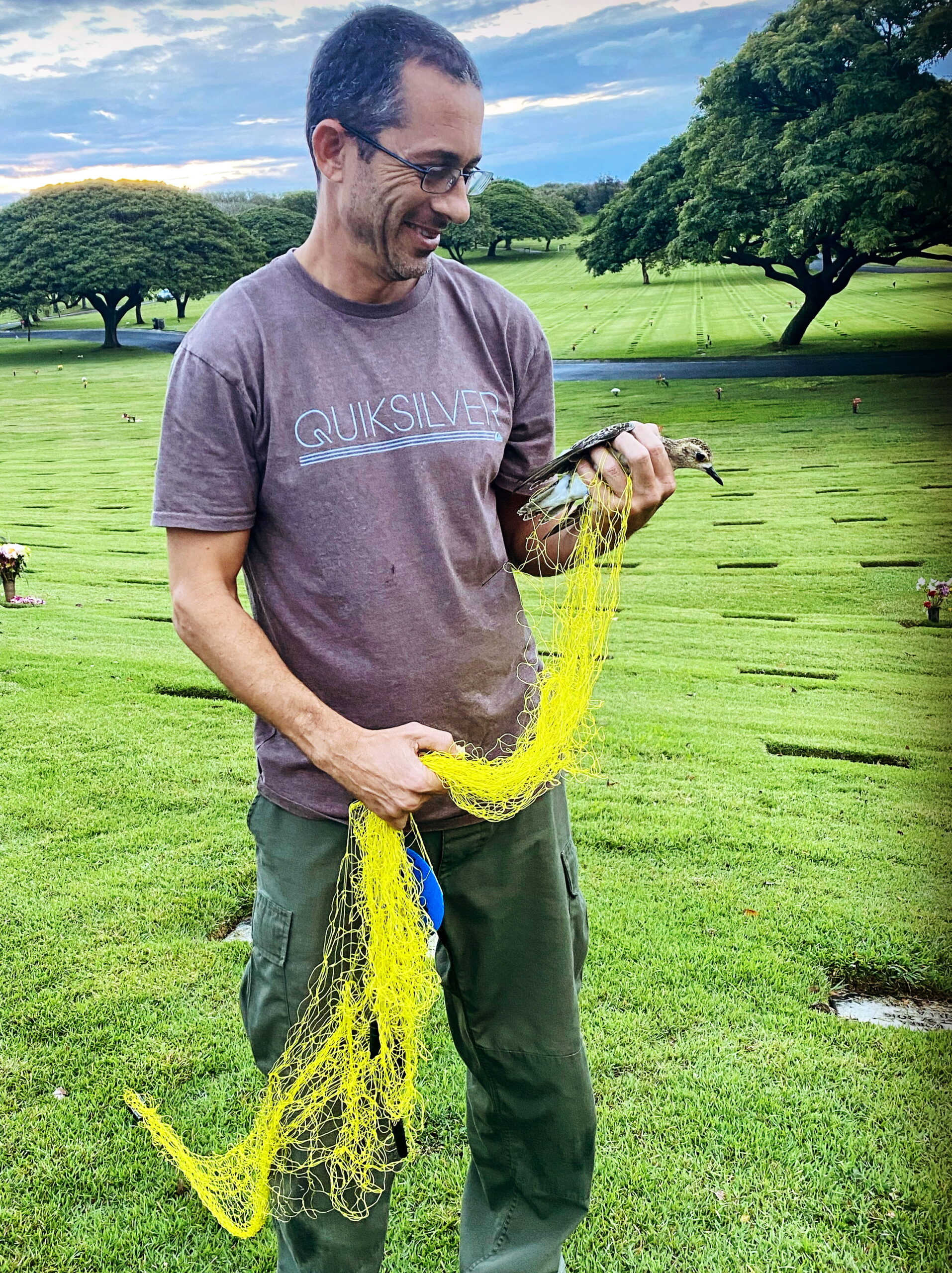 Josh with his hard-earned prize kōlea, November 29, 2023. Wally Johnson photo
Josh with his hard-earned prize kōlea, November 29, 2023. Wally Johnson photo 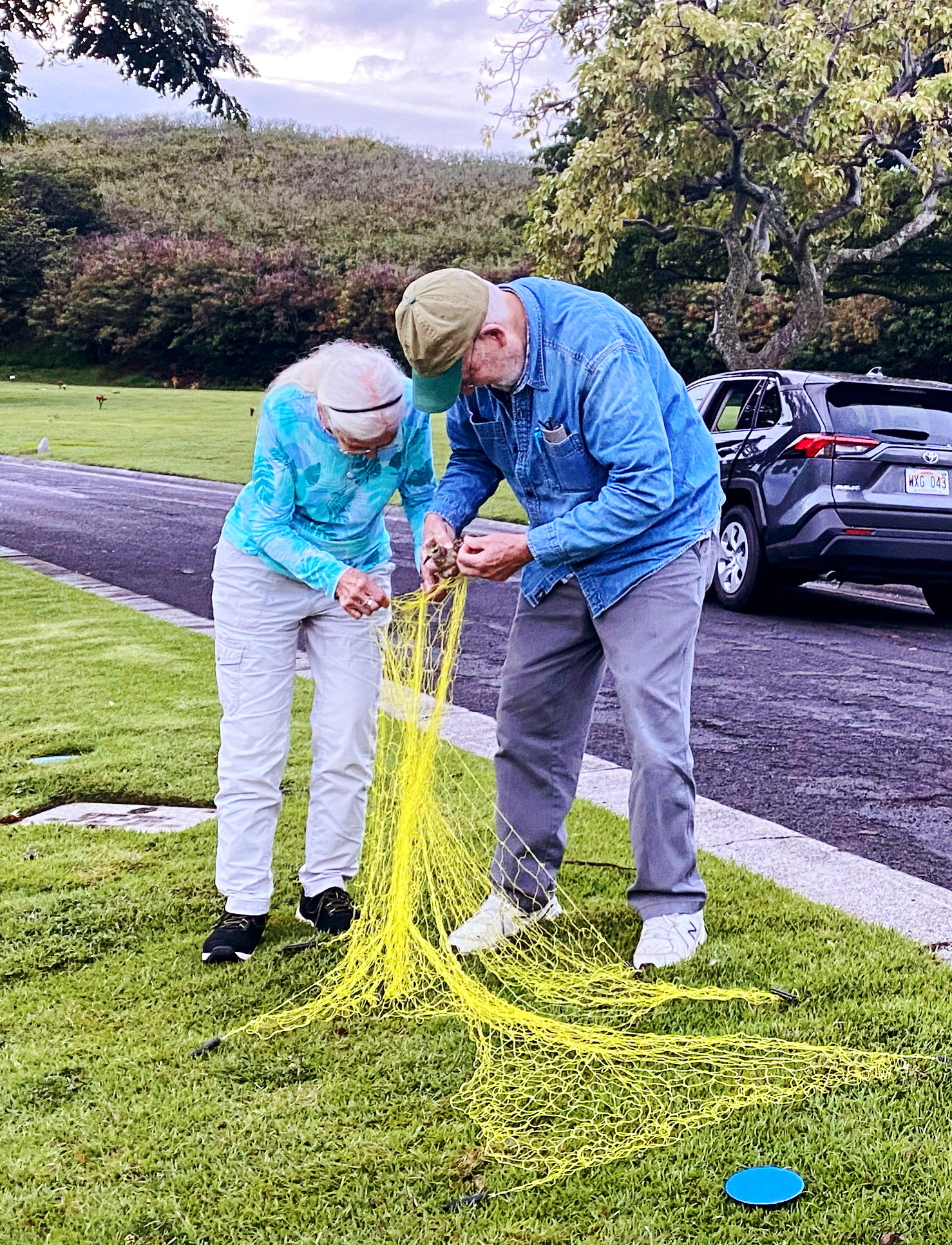 Wally Johnson and partner Diane Smith untangle the kōlea from the net. Josh Fisher photo
Wally Johnson and partner Diane Smith untangle the kōlea from the net. Josh Fisher photo 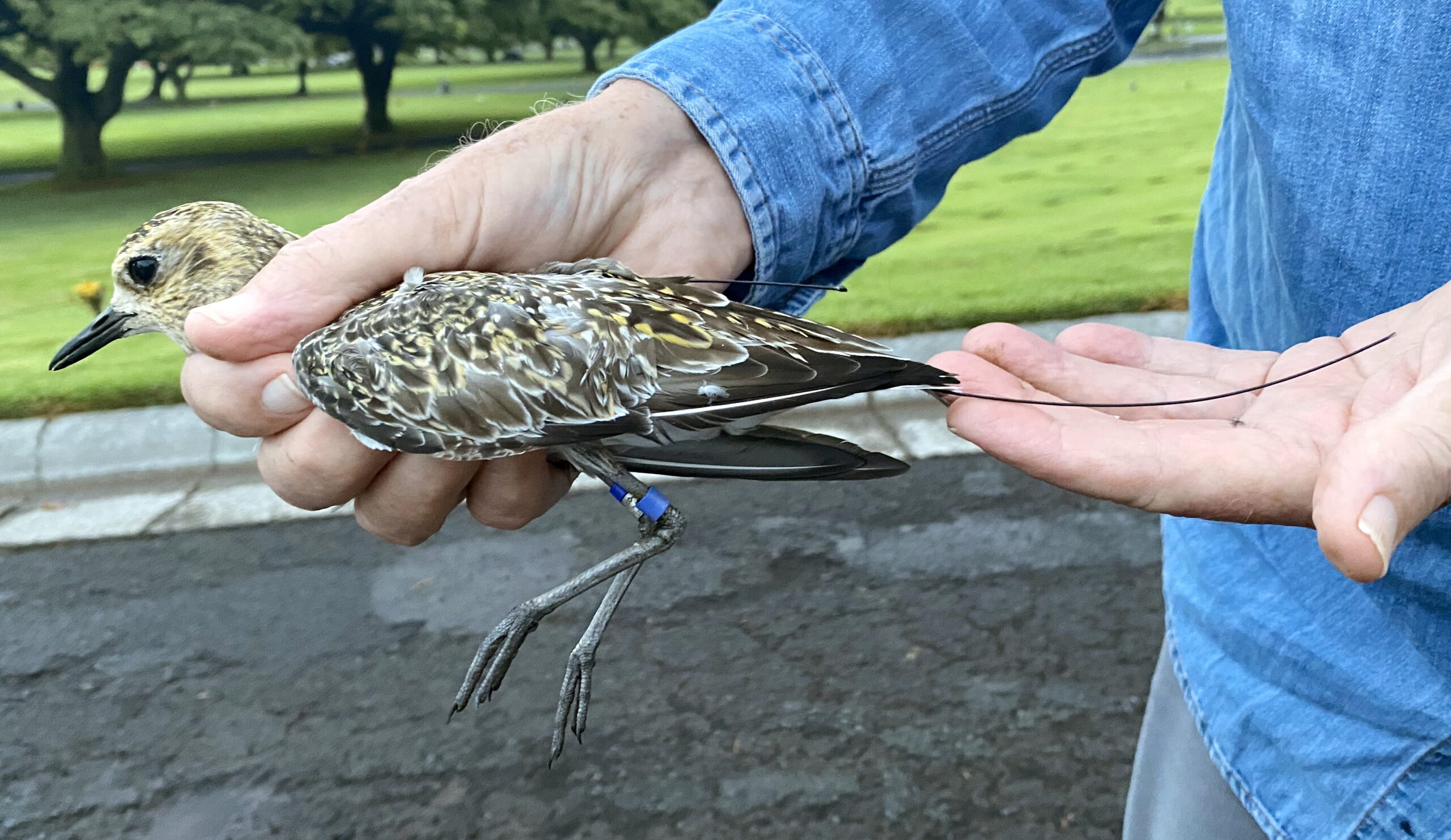
 Mr. X with his 21-year-old aluminum band. Tom Fake photo
Mr. X with his 21-year-old aluminum band. Tom Fake photo